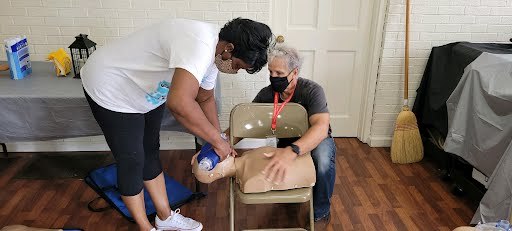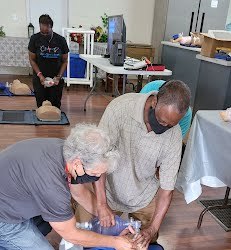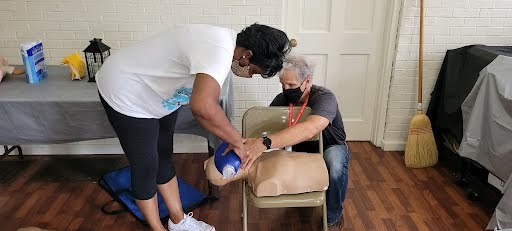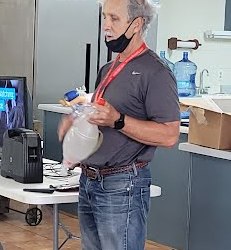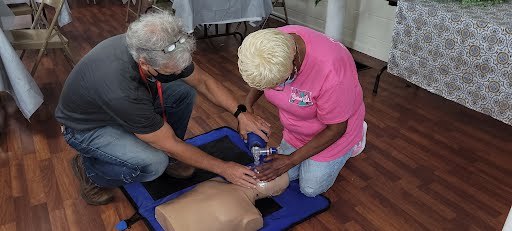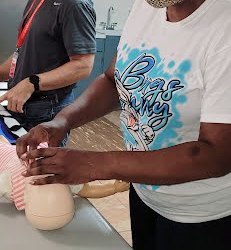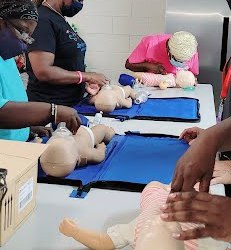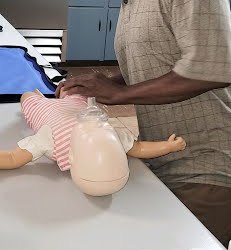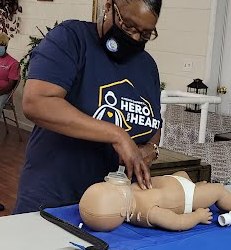#augusta bls classes
Text
#cpr#cpr training#first aid cpr#augusta bls classes#cpr bls acls pulsecpr#cpr certification#cprtraining
0 notes
Text
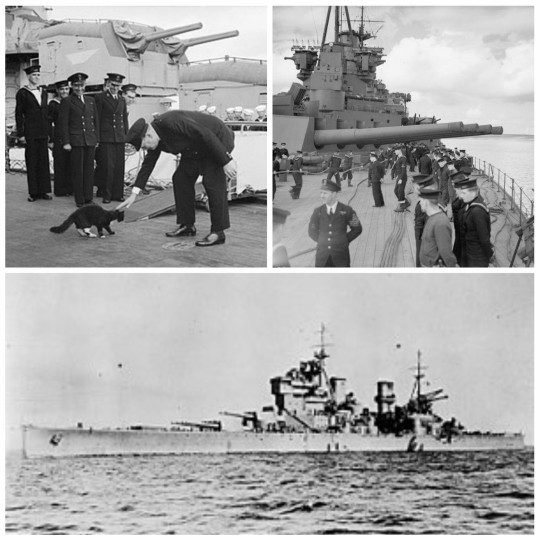
• HMS Prince of Wales
HMS Prince of Wales was a King George V-class battleship of the British Royal Navy. She had an extensive battle history, first seeing action in August 1940 while in her drydock when she was attacked by German aircraft.
In the aftermath of the First World War, the Washington Naval Treaty was drawn up in 1922 in an effort to stop an arms race developing between Britain, Japan, France, Italy and the United States. This treaty limited the number of ships each nation was allowed to build, and capped the tonnage of all capital ships at 35,000 tons. These restrictions were extended in 1930 through the Treaty of London, however, by the mid-1930s Japan and Italy had withdrawn from both of these treaties, and the British became concerned about a lack of modern battleships within their navy. As a result, the Admiralty ordered the construction of a new battleship class: the King George V class.
The main armament of the class was limited to the 14-inch (356 mm) guns prescribed under these instruments. They were the only battleships built at that time to adhere to the treaty, and even though it soon became apparent to the British that the other signatories to the treaty were ignoring its requirements, it was too late to change the design of the class before they were laid down in 1937. Prince of Wales was originally named King Edward VIII but upon his abdication the ship was renamed before she had been laid down. This occurred at Cammell Laird's shipyard in Birkenhead on January 1st, 1937, although it was not until May 3rd, 1939 that she was launched. She was still fitting out when war was declared in September, causing her construction schedule, and that of her sister, King George V, to be accelerated. During early August 1940, while she was still being outfitted and was in a semi-complete state, Prince of Wales was attacked by German aircraft. One bomb fell between the ship and a wet basin wall, narrowly missing a 100-ton dockside crane, and exploded underwater below the bilge keel. Buckling of the shell plating took place over a distance of 20 to 30 feet (9.1 m), rivets were sprung and considerable flooding took place in the port outboard compartments in the area of damage, causing a ten-degree port list. The flooding was severe, due to the fact that final compartment air tests had not yet been made and the ship did not have her pumping system in operation. The water was pumped out through the joint efforts of a local fire company and the shipyard, and Prince of Wales was later dry docked for permanent repairs. This damage and the problem with the delivery of her main guns and turrets delayed her completion. As the war progressed there was an urgent need for capital ships, and so her completion was advanced by postponing compartment air tests, ventilation tests and a thorough testing of her bilge and fuel oil systems.
She was powered by Parsons geared steam turbines, driving four propeller shafts. Steam was provided by eight Admiralty boilers which normally delivered 100,000 shaft horsepower (75,000 kW). This gave Prince of Wales a top speed of 28 knots (52 km/h; 32 mph). She also carried 180 long tons (200 t) of diesel oil, 256 long tons (300 t) of reserve feed water and 444 long tons (500 t) of freshwater. Prince of Wales had a range of 3,100 nautical miles (5,700 km; 3,600 mi) at 27 knots (50 km/h; 31 mph). Prince of Wales mounted 10 BL 14-inch (356 mm) Mk VII guns. The 14-inch guns were mounted in one Mark II twin turret forward and two Mark III quadruple turrets, one forward and one aft. The secondary armament consisted of 16 QF 5.25-inch (133 mm) Mk I guns which were mounted in eight twin mounts, weighing 81 tons each. Along with her main and secondary batteries, Prince of Wales carried 32 QF 2 pdr (1.575-inch, 40.0 mm) Mk.VIII "pom-pom" anti-aircraft guns. She also carried 80 UP projectors, which were short range rocket firing anti-aircraft weapons used extensively in the early days of the Second World War.
On May 22nd, 1941, Prince of Wales, the battlecruiser Hood and six destroyers were ordered to take station south of Iceland and intercept the German battleship Bismarck if she attempted to break out into the Atlantic. Captain John Leach knew that main-battery breakdowns were likely to occur, since Vickers-Armstrongs technicians had already corrected some that took place during training exercises in Scapa Flow. The next day Bismarck, in company with the heavy cruiser Prinz Eugen, was reported heading south-westward in the Denmark Strait. At 20:00 Vice-Admiral Lancelot Holland, in his flagship Hood, ordered the force to steam at 27 knots (50 km/h), which it did most of the night. His battle plan called for Prince of Wales and Hood to concentrate on Bismarck, while the cruisers Norfolk and Suffolk would handle Prinz Eugen. However the two cruisers were not informed of this plan because of strict radio silence. At 02:00, on 24 May, the destroyers were sent as a screen to search for the German ships to the north. At 05:37 an enemy contact report was made, and course was changed to starboard to close range. Neither ship was in good fighting trim. Hood, designed twenty-five years earlier, lacked adequate decking armour and would have to close the range quickly, as she would become progressively less vulnerable to plunging shellfire at shorter ranges. She had completed an overhaul in March and her crew had not been adequately retrained. Prince of Wales, with thicker armour, was less vulnerable to 15-inch shells at ranges greater than 17,000 feet (5,200 m), but her crew had also not been trained to battle efficiency.
At 05:53, despite seas breaking over the bows, Prince of Wales opened fire on Bismarck at 26,500 yards (24,200 m). There was some confusion among the British as to which ship was Bismarck and thirty seconds earlier Hood had mistakenly opened fire on Prinz Eugen as the German ships had similar profiles. Hood's first salvo straddled the enemy ship, but Prinz Eugen, in less than three minutes, scored 8-inch-shell hits on Hood. The first shots by Prince of Wales two three-gun salvoes at ten second intervals were 1,000 yards over. The sixth, ninth and thirteenth salvos were straddles and two hits were made on Bismarck. One shell holed her bow and caused Bismarck to lose 1,000 tons of fuel oil, mostly to salt-water contamination. The other fell short, and entered Bismarck below her side armour belt, the shell exploded and flooded the auxiliary boiler machinery room and forced the shutdown of two boilers due to a slow leak in the boiler room. Both German ships initially concentrated their fire on Hood and destroyed her with salvoes of 8- and 15-inch shells. Prince of Wales fired unopposed until she began a port turn at 05:57, when Prinz Eugen took her under fire. After Hood exploded at 06:01, the Germans opened intense and accurate fire on Prince of Wales, with 15-inch, 8-inch and 5.9-inch guns. A heavy hit was sustained below the waterline as Prince of Wales manoeuvred through the wreckage of Hood. At 06:02, a 15-inch shell struck the starboard side of the compass platform and killed the majority of the personnel there.
At 06:05 Captain Leach decided to disengage and laid down a heavy smokescreen to cover Prince of Wales's escape. Following this, Leach radioed the Norfolk that Hood had been sunk and then proceeded to join Suffolk roughly 15 to 17 miles (24 to 27 km) astern of Bismarck. Throughout the day the British ships continued to chase Bismarck until at 18:16 when Suffolk sighted the German battleship at 22,000 yards (20,000 m). Prince of Wales then opened fire on Bismarck at an extreme range of 30,300 yards (27,700 m), she fired 12 salvos but all of them missed. After losing Bismarck owing to poor visibility and after searching for 12 hours, Prince of Wales headed for Iceland and took no further part in actions against Bismarck.
Following repairs at Rosyth, Prince of Wales transported Prime Minister Winston Churchill across the Atlantic for a secret conference with US President Franklin D. Roosevelt. On August 5th, Roosevelt boarded the cruiser USS Augusta from the presidential yacht Potomac. Augusta proceeded from Massachusetts to Placentia Bay and Argentia in Newfoundland with the cruiser USS Tuscaloosa and five destroyers, arriving on August 7th. On August 9th, Churchill arrived in the bay aboard Prince of Wales, escorted by the destroyers HMS Ripley, HMCS Assiniboine and HMCS Restigouche. At Placentia Bay, Newfoundland, Roosevelt transferred to the destroyer USS McDougal to meet Churchill on board Prince of Wales. The conference continued from 10 to 12 August aboard the heavy cruiser USS Augusta and, at the end of the conference, the Atlantic Charter was proclaimed.
In September 1941, Prince of Wales was assigned to Force H, in the Mediterranean. On September 24th, Prince of Wales formed part of Group II, led by Vice-Admiral Alban Curteis. The force provided an escort for Operation Halberd, a supply convoy from Gibraltar to Malta. On September 27th, the convoy was attacked by Italian aircraft, with Prince of Wales shooting down several with her 5.25-inch (133 mm) guns. Later that day there were reports that units of the Italian Fleet were approaching. Prince of Wales, the battleship Rodney and the aircraft carrier Ark Royal were despatched to intercept, but the search proved fruitless. The convoy arrived in Malta without further incident, and Prince of Wales returned to Gibraltar.
On October 25th, Prince of Wales and a destroyer escort left home waters bound for Singapore, there to rendezvous with the battlecruiser Repulse and the aircraft carrier Indomitable. Indomitable however ran aground off Jamaica a few days later and was unable to proceed. Prince of Wales reached Colombo, Ceylon, on November 28th, joining Repulse the next day. On December 2nd, the fleet docked in Singapore. Prince of Wales then became the flagship of Force Z, under the command of Admiral Sir Tom Phillips. Japanese troop-convoys were first sighted on 6 December. Two days later, Japanese aircraft raided Singapore; although the Prince of Wales's anti-aircraft batteries opened fire, they scored no hits and had no effect on the Japanese aircraft. A signal was received from the Admiralty in London ordering the British squadron to commence hostilities, and that evening, confident that a protective air umbrella would be provided by the RAF presence in the region, Admiral Phillips set sail. The object of the sortie was to attack Japanese transports at Kota Bharu, but in the afternoon of 9 December the Japanese submarine I-65 spotted the British ships, and in the evening they were detected by Japanese aerial reconnaissance. By this time it had been made clear that no RAF fighter support would be forthcoming. At midnight a signal was received that Japanese forces were landing at Kuantan in Malaya. Force Z was diverted to investigate. At 02:11 on December 10th, the force was again sighted by a Japanese submarine and at 08:00 arrived off Kuantan, only to discover that the reported landings were a diversion.
At 11:00 that morning the first Japanese air attack began. Eight Type 96 "Nell" bombers dropped their bombs close to Repulse, one passing through the hangar roof and exploding on the 1-inch plating of the main deck below. Despite reports to the contrary, Prince of Wales was struck by only one torpedo. Meanwhile, Repulse avoided the seven torpedoes aimed at her, as well as bombs dropped by six other "Nells" a few minutes later. The torpedo struck Prince of Wales on the port side aft, abaft "Y" Turret, wrecking the outer propeller shaft on that side and destroying bulkheads to one degree or another along the shaft all the way to B Engine Room. This caused rapid uncontrollable flooding and put the entire electrical system in the after part of the ship out of action. Lacking effective damage control, she soon took on a heavy list. A fourth attack was conducted, this one scored hits on Repulse and she sank at 12:33. Six aircraft from this wave also attacked Prince of Wales, hitting her with three torpedoes, causing further damage and flooding. Finally, a 500-kilogram (1,100 lb) bomb hit Prince of Wales's catapult deck, penetrated to the main deck, where it exploded, causing many casualties in the makeshift aid centre in the Cinema Flat. Several other bombs from this attack scored very 'near misses', indenting the hull, popping rivets and causing hull plates to 'split' along the seams and intensifying the flooding. At 13:15 the order to abandon ship was given, and at 13:20 Prince of Wales capsized and sank; Admiral Phillips and Captain Leach were among the 327 fatalities.
Prince of Wales and Repulse were the first capital ships to be sunk solely by naval air power on the open sea (albeit by land-based rather than carrier-based aircraft), a harbinger of the diminishing role this class of ships was to play in naval warfare thereafter. It is often pointed out, however, that contributing factors to the sinking of Prince of Wales were her surface-scanning radars being inoperable in the humid tropic climate, depriving Force Z of one of its most potent early-warning devices and the critical early damage she sustained from the first torpedo. The wreck lies upside down in 223 feet (68 m) of water at 3°33′36″N 104°28′42″E. A Royal Navy White Ensign attached to a line on a buoy tied to a propeller shaft is periodically renewed. The wreck site was designated a 'Protected Place' in 2001 under the Protection of Military Remains Act 1986, just prior to the 60th anniversary of her sinking.
#second world war#world war 2#royal navy#british#british history#wwii#ww2#naval history#prince of wales#british navy
20 notes
·
View notes
Text
Mastering Basic Life Support Exams A and B: Your Guide to Success
Mastering Basic Life Support Exams A and B: Your Guide to Success
At Pulse CPR and First Aid School, we understand the importance of excelling in your Basic Life Support (BLS) certification exams. Whether you're preparing for Exam A or B, our comprehensive guide will help you master the essential skills and knowledge needed to pass with flying colors. Let's dive into what you need to know about the American Heart Association's Basic Life Support Exams A and B.
Understanding Basic Life Support Exams A and B
The American Heart Association (AHA) offers two primary versions of the BLS exam: Exam A and Exam B. Both exams assess your ability to perform high-quality CPR, use an AED, and manage choking scenarios. Here’s a breakdown of what each exam entails:
Exam A Overview
Number of Questions: 25
Focus Areas:
Adult, child, and infant CPR techniques
AED usage
Team dynamics in resuscitation
Responding to airway obstructions
Importance of early defibrillation
Effective communication during CPR
Exam B Overview
Number of Questions: 25
Focus Areas:
Similar to Exam A with slight variations in scenario-based questions
Emphasis on teamwork and detailed understanding of CPR cycles
Handling special circumstances like drowning or medication patches
Key Topics Covered in Both Exams
CPR Techniques
Knowing the correct ratios and techniques for chest compressions and rescue breaths is crucial. For instance, the standard ratio for 1-rescuer adult CPR is 30 compressions to 2 breaths. For infants, it's also important to remember specific guidelines, like using two fingers for compressions if you are alone.
AED Usage
Understanding how to properly use an AED is a critical component. Remember to:
Turn on the AED as soon as it arrives.
Apply the pads correctly on the victim's bare chest.
Follow the AED prompts accurately.
Team Dynamics
Effective resuscitation often involves teamwork. Key elements include:
Clear roles and responsibilities
Knowing your limitations
Mutual respect and effective communication
Responding to Airway Obstructions
Both exams test your ability to respond to choking incidents. For instance, if an infant is choking and becomes unresponsive, start CPR and check the mouth for the obstructing object before giving breaths.
Importance of Early Defibrillation
Early defibrillation can significantly improve survival rates during cardiac arrest. Both exams emphasize the importance of using an AED promptly and following its instructions to restore a normal heart rhythm.
Tips for Success
Study Regularly: Consistent study sessions can help reinforce the material.
Practice Hands-On Skills: Practical experience is invaluable. Use manikins to practice CPR and AED usage.
Review AHA Guidelines: Ensure you are familiar with the latest AHA guidelines for BLS.
Take Practice Tests: Familiarize yourself with the exam format by taking practice tests for both Exam A and Exam B.
Why Choose Pulse CPR and First Aid School?
At Pulse CPR and First Aid School, we are dedicated to providing top-notch training that prepares you for real-life emergencies and certification exams. Our experienced instructors, hands-on training sessions, and supportive learning environment ensure you gain the confidence and skills needed to excel.
Enroll Today
Ready to ace your Basic Life Support Exams A and B? Enroll in our BLS certification courses today and take the first step towards becoming a lifesaver. Visit our website or contact us to learn more about our classes and schedules.
#cpr#cpr training#cpr bls acls pulsecpr#cprtraining#first aid cpr#cpr certification#augusta bls classes
0 notes
Text
PULSE CPR AUGUSTA GA
PULSE CPR AUGUSTA GA
MAY 9, 2024 / BY ADMIN / LEAVE A COMMENT EDIT
Do you know how to respond in a medical emergency? Being equipped with life-saving skills like CPR (Cardiopulmonary Resuscitation) can make all the difference. Pulse CPR, nestled in Evans Martinez and Augusta GA, stands as a beacon of preparedness and safety in the heart of Georgia. Let’s dive into what makes Pulse CPR a vital resource for the community.
Location and Contact Info
Located at 110 Davis Rd, Martinez, GA, Suite #18 Pulse CPR offers a range of courses aimed at equipping individuals and organizations with the skills necessary to respond effectively in emergencies. You can reach them at +1 706-901-7277 or drop them an email at [email protected]. With a stellar 5.0 rating based on 14 reviews, it’s clear that their commitment to excellence shines through.
Courses Offered
Pulse CPR offers a variety of courses catering to different needs and skill levels. Whether you’re a healthcare professional requiring Basic Life Support (BLS) certification or a concerned citizen wanting to learn CPR and First Aid, Pulse CPR has you covered. Their courses are certified by the American Heart Association, ensuring that participants receive training of the highest standard.
The Importance of CPR
Cardiac arrest can happen anytime, anywhere, to anyone. Knowing CPR can double or even triple the chances of survival for someone experiencing cardiac arrest. Pulse CPR emphasizes the importance of immediate intervention, teaching participants not only how to perform CPR but also how to use automated external defibrillators (AEDs) effectively.
Community Partnerships
Pulse CPR is more than just a training center; it’s a partner in community safety. Partnering with organizations like North Augusta Pediatrics, Pulse CPR ensures that medical professionals are well-equipped to handle emergencies. Their commitment to spreading awareness and training extends beyond traditional classroom settings, with on-site corporate training programs tailored to the specific needs of businesses, churches, schools, and civic groups.
Innovative Approach
What sets Pulse CPR apart is its innovative approach to training. With experienced professionals, including nurses and fitness experts, at the helm, Pulse CPR goes beyond textbook learning, offering practical insights and real-world scenarios. Their flexible class schedules make it easy for busy individuals to prioritize their safety without disrupting their daily routines.
Stay Informed, Stay Prepared
Pulse CPR doesn’t just stop at teaching CPR and First Aid. They’re also dedicated to keeping the community informed about the latest developments in healthcare and emergency preparedness. From highlighting the connection between sleep disorders and heart conditions to sharing inspiring stories of survival, Pulse CPR’s online presence serves as a valuable resource for staying informed and prepared.
In conclusion, Pulse CPR Augusta GA is more than just a training center; it’s a lifeline for the community. By equipping individuals with life-saving skills and fostering a culture of preparedness, Pulse CPR is empowering people to make a difference when it matters most. So why wait? Take the proactive step towards saving lives today with Pulse CPR.
#cpr#cpr training#augusta bls classes#cpr bls acls pulsecpr#cpr certification#first aid cpr#cprtraining
0 notes
Text
#cpr certification#cpr#cpr bls acls pulsecpr#first aid cpr#augusta bls classes#cprtraining#cpr training
0 notes
Text
AED certification Georgia
Unveiling Career Prospects with AED Certification in Georgia
Meta Description: Dive into the world of AED certification in Georgia and explore the career avenues it unlocks. Learn about the certification process, career pathways, and essential resources to embark on your journey in cardiac emergency response.
Introduction: Welcome to our Tumblr blog post where we uncover the realm of AED certification in Georgia and its impact on career opportunities. Whether you're a healthcare enthusiast, a fitness aficionado, or a concerned citizen, acquiring AED certification can be a game-changer in your professional journey. Let's delve into the intricacies of AED certification, Georgia's unique landscape, and how this credential can elevate your career prospects.
Understanding AED Certification: AED certification isn't just about learning how to use a life-saving device; it's about empowering yourself to be a first responder in critical situations. In Georgia, where diverse communities thrive and bustling urban centers demand swift action, AED certification is a valuable asset. It equips you with the skills to confidently handle cardiac emergencies, potentially saving lives in the process.
The Significance in Georgia: Georgia's dynamic healthcare landscape underscores the importance of AED certification. From urban hubs to rural communities, cardiac emergencies can strike anywhere. With AED certification, you become a beacon of hope, ready to intervene when every second counts. Moreover, many industries, including healthcare, fitness, and corporate sectors, prioritize AED-trained individuals, presenting abundant career opportunities.
Obtaining AED Certification in Georgia: Getting AED certified in Georgia is easier than you think. Accredited training providers offer flexible courses, including online options, tailored to fit your schedule. These courses cover essential topics like CPR, AED operation, and basic life support techniques. With convenient access to training, you can kickstart your journey towards certification with ease.
Exploring Career Opportunities: AED certification opens doors to diverse career pathways in Georgia. Whether you're a healthcare professional, a fitness instructor, or an office employee, your AED skills are in demand. Hospitals, gyms, schools, and corporate offices are just a few places where AED-trained individuals are sought after. By showcasing your certification, you enhance your employability and position yourself as a valuable asset in any setting.
Maximizing Your Career Potential: To maximize the benefits of AED certification, stay updated with the latest guidelines and renew your certification regularly. Networking with peers and industry professionals can also open doors to exciting career opportunities. Remember, your AED certification isn't just a piece of paper—it's a testament to your commitment to saving lives and making a difference in your community.
Conclusion: As we wrap up our Tumblr blog post, remember that AED certification in Georgia isn't just about earning a credential—it's about unlocking a world of possibilities. Whether you're embarking on a new career path or enhancing your existing skills, AED certification empowers you to be a beacon of hope in times of need. So, take the leap, get certified, and embark on your journey to becoming a lifesaving hero in Georgia's vibrant communities.
#cpr training#first aid cpr#cpr bls acls pulsecpr#cprtraining#augusta bls classes#cpr#cpr certification
0 notes
Text

#cpr certification#cpr#augusta bls classes#cpr bls acls pulsecpr#first aid cpr#cpr training#cprtraining
0 notes
Text
#cpr#first aid cpr#cpr bls acls pulsecpr#augusta bls classes#cpr training#cprtraining#cpr certification
0 notes
Text
#cpr certification#first aid cpr#augusta bls classes#cpr bls acls pulsecpr#cprtraining#cpr training#cpr
0 notes
Text
Damar Hamlin's #3forHeart CPR Challenge: Turning Bystanders into Lifesavers
Damar Hamlin's #3forHeart CPR Challenge: Turning Bystanders into Lifesavers
Cardiac arrest survivor Damar Hamlin, wearing jersey No. 3 for the Buffalo Bills, has embarked on a mission to empower individuals with lifesaving skills through the #3forHeart CPR Challenge. Following his own harrowing experience of cardiac arrest during an NFL game, Hamlin is urging everyone to take three simple steps to become lifesavers.
Step 1: Learn Hands-Only CPR Hamlin encourages individuals to visit heart.org/3 and watch a 60-second video to learn Hands-Only CPR. This technique involves using only hands to perform chest compressions, eliminating the need for mouth-to-mouth breathing.
Step 2: Donate to the American Heart Association Support CPR education, training, and other lifesaving programs by donating to the American Heart Association. Your contribution can help fund initiatives that increase access to CPR training and automated external defibrillators (AEDs), ultimately saving more lives.
Step 3: Spread the Word on Social Media Join the #3forHeart CPR Challenge by posting on social media that you've taken the challenge and tagging three friends to encourage them to participate. By spreading awareness, you can inspire others to learn CPR and potentially save lives in their communities.
Hamlin's initiative comes at a crucial time, coinciding with American Heart Month in February. With the American Heart Association already focusing on CPR awareness, Hamlin's advocacy adds momentum to the campaign, emphasizing the importance of immediate CPR intervention in cardiac arrest situations.
Cardiac arrest is a life-threatening emergency that requires prompt action. By learning Hands-Only CPR and participating in the #3forHeart Challenge, individuals can play a crucial role in the chain of survival and increase the chances of survival for those experiencing cardiac arrest.
Hamlin's personal journey serves as a powerful reminder of the impact of CPR and the importance of community readiness in responding to cardiac emergencies. Together, we can turn bystanders into lifesavers and create safer communities for everyone.
Join Damar Hamlin's #3forHeart CPR Challenge today and help save lives one heartbeat at a time.
#cpr certification#augusta bls classes#cprtraining#cpr bls acls pulsecpr#cpr training#cpr#first aid cpr
0 notes
Text
Discover Top-Rated American Heart Association CPR Classes Near You in Martinez, GA 30907
American Heart Association CPR Classes: Your Path to Lifesaving Skills
Are you searching for reliable American Heart Association (AHA) CPR classes near Martinez, GA 30907? Look no further! At Pulse CPR and First Aid School, we're dedicated to equipping individuals and healthcare professionals with the knowledge and skills needed to respond effectively in emergencies.
Why Choose American Heart Association CPR Classes?
1. Gold Standard Certification:
When it comes to CPR certification, the American Heart Association sets the gold standard. Their courses are developed and updated based on the latest evidence-based guidelines, ensuring you receive the most accurate and up-to-date training.
2. Recognized by Employers:
AHA CPR certification is widely recognized by employers across various industries, including healthcare, education, and fitness. By completing an AHA course, you enhance your employability and demonstrate your commitment to safety and preparedness.
3. Comprehensive Training:
Our AHA CPR classes cover a range of essential topics, including adult, child, and infant CPR, AED (Automated External Defibrillator) use, and choking relief techniques. Whether you're a healthcare professional or a concerned citizen, our courses are designed to meet your specific needs and skill level.
Experience the Pulse CPR Advantage
At Pulse CPR and First Aid School, we prioritize quality, convenience, and affordability. Here's what sets us apart:
Experienced Instructors: Our instructors are certified healthcare professionals with years of experience in CPR training and emergency response.
Flexible Scheduling: We offer flexible class schedules to accommodate busy lifestyles. Whether you prefer weekday, weekend, or evening classes, we have options to suit your schedule.
State-of-the-Art Facilities: Our training facilities are equipped with the latest training materials and equipment, providing a comfortable and conducive learning environment.
Register Today!
Don't wait until it's too late. Take the first step towards preparedness by enrolling in our American Heart Association CPR classes in Martinez, GA 30907. Call us at 706-901-7277 to reserve your spot or visit our website for more information.
Meta Tags: American Heart Association CPR classes, CPR certification, Martinez GA 30907, Pulse CPR and First Aid School, AHA CPR courses
References:
American Heart Association Official Website
CPR Certification Institute
American Red Cross CPR Training
#cpr#cpr certification#cpr training#first aid cpr#augusta bls classes#cpr bls acls pulsecpr#cprtraining#male cpr#cpr resus
0 notes
Link
BLS CPR for Nursing Students in Augusta: Enhance Your Skills with Pulse CPR and First Aid School Why BLS CPR Certification is Essential for Nursing StudentsWhy BLS CPR Certification is Essential for Nursing Students Basic Life Support (BLS) CPR certification is a critical requirement for nursing students. As future healthcare professionals, understanding how to perform […]
0 notes
Link
Cardiopulmonary Resuscitation (CPR) is a life-saving technique used to restore normal body function in cases of cardiac arrest or when breathing patterns have stopped. Proper training in CPR can enable you to restart a person’s heart or breathing to save their life. Administering CPR involves mouth-to-mouth resuscitation and, if necessary, chest compressions. Knowing how to […]
0 notes
Link
Basic Life Support (BLS) certification is a vital qualification for healthcare professionals who work in emergency medical services. If you’re located in Augusta, GA, and are looking for a reputable BLS certification provider, Pulse CPR School in Martinez, GA, is an excellent choice. Pulse CPR School is an American Heart Association (AHA) approved training center […]
0 notes
Link
Basic Life Support (BLS) certification is a vital qualification for healthcare professionals who work in emergency medical services. If you’re located in Augusta, GA, and are looking for a reputable BLS certification provider, Pulse CPR School in Martinez, GA, is an excellent choice. Pulse CPR School is an American Heart Association (AHA) approved training center […]
0 notes
